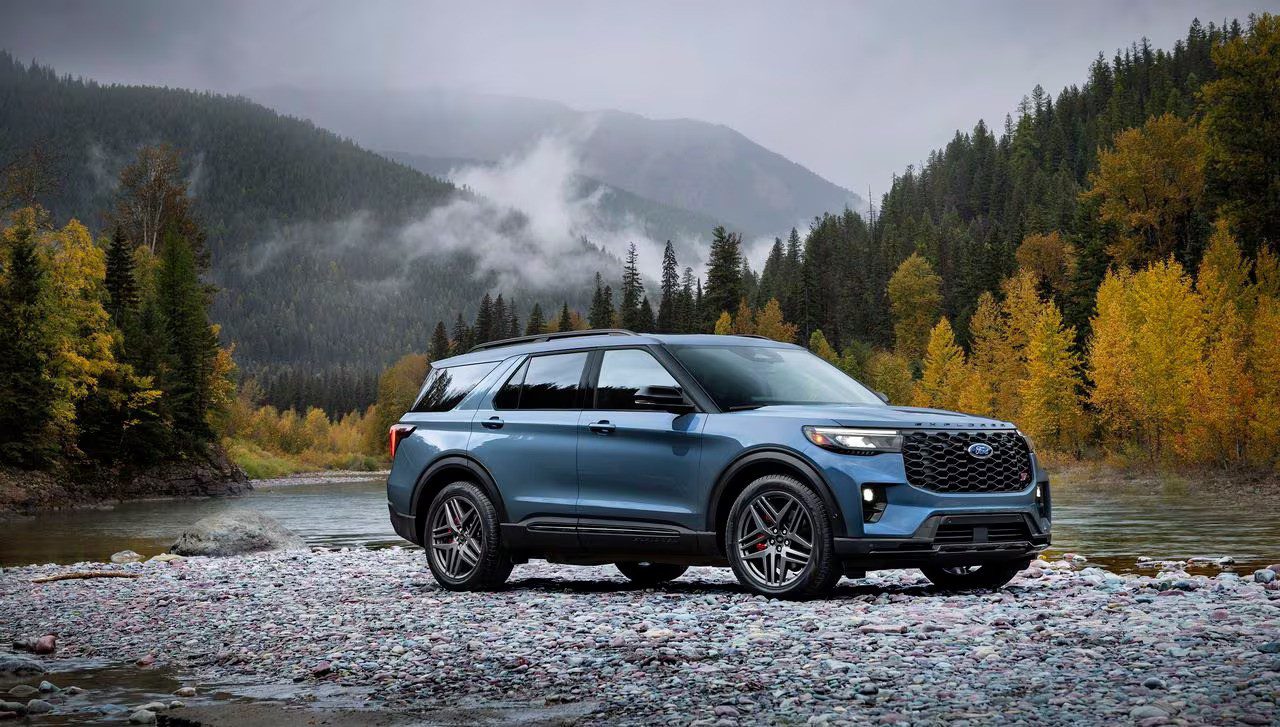DURBORNE, Michigan - The updated 2025 Ford Explorer aims to attract millennial buyers with greater capabilities, the BlueCruise voice system, and a new digital Ford experience, although customers will not be able to purchase it as a hybrid.
Younger families — the largest generation since the baby boomers — demand more from their vehicles than just casual trips, according to Ford Motor Co. representatives, wanting to stay connected and seek adventures. The new models of the automaker’s best-selling SUV from Dyrbourne, last updated in 2020, feature an updated interior, more advanced technology, and more standard features to better meet their needs.
"When we look at our powerful and rugged Explorer, we know it truly appeals to adventurous spirits, customers who want to be confident and have the necessary capabilities — whether it's taking kids to hockey practice or escaping on a hike," said Trevor Scott, Ford Family Vehicles General Manager, during a product briefing. "We want our customers to know that Explorer has not only style but also the capabilities and versatility they seek for the entire family."
Pre-orders for the three-row SUV with options for six or seven passengers began on Thursday with a starting retail price of $41,220, including delivery charges. Vehicles assembled in Chicago will start arriving at dealerships in the second quarter.
Despite efforts by Ford to emphasize hybrid powertrains amidst slower-than-expected electric vehicle sales growth, the company last year announced it would eliminate the hybrid option in the Explorer lineup. According to Ford representatives, this does not contradict the automaker's ambitions but is part of efforts to prioritize hybrids for Ford Police Interceptor Utility patrol vehicles based on Explorer, which are in demand due to lower operating costs, as well as for vehicles where hybrids are popular among customers, such as the full-size F-150 pickup and the Maverick small pickup.
"It's clear that our first responders prefer hybrids, and that's why we are leaning toward them," says Kelly Clark, Explorer Chief Program Engineer.
The number of vehicle configurations has been reduced by approximately 95%, from hundreds to fewer than 42, as Ford strives to improve quality and simplify the purchasing process. For example, the Class III trailer towing package with a 5,000-pound capacity is now standard on all models, along with blind-spot detection, adaptive cruise control, automatic emergency braking, seven drive modes, and other features. This simplification eliminates about 1,300 parts, reducing the need for component compatibility and increasing the likelihood of correct assembly on the first attempt.
"Explorer is already built on a solid foundation," said Clark. "Our customers appreciate the performance; they look at capabilities, safety, and interior space. We aren't changing that. The only thing we're doing is giving them more standard features. These are features our customers tell us they like, use, or want."
The 2025 Explorer is available with a 2.3-liter four-cylinder Ecoboost engine or a 3.0-liter Ecoboost V-6, which accounted for most of the nearly 187,000 Explorer sales in the U.S. last year. The more powerful Explorer ST comes standard with the 3.0-liter Ecoboost engine, delivering 400 horsepower and 415 lb-ft of torque, with rear-wheel drive as standard. All-wheel drive is available.
According to Sem Abuelsamide, chief electronic mobility analyst at Guidehouse Inc., the hybrid Explorer is not particularly economical for retail customers.
"Police vehicles spend a lot of time idling. Hybrids make much more sense for them," he said. "For regular drivers, there is some fuel savings, but it’s not significant considering the cost."
The absence of a hybrid powertrain does not make the updated Explorer less technologically advanced. For the first time, drivers in the Explorer ST-Line, ST, and Platinum trims will get access to the BlueCruise system. It is not available on the Active models. The ST-Line is expected to become the most popular model, followed by the Active, and then the ST, which accounts for about 20% of sales.
"One press of the BlueCruise button allows you to take your hands off the wheel and feet off the pedals. The autopilot manages steering, acceleration, and braking, keeping you in your lane and at a safe distance from vehicles ahead," explains Ashley Lambrix, BlueCruise General Manager. "It takes the work out of driving without removing the enjoyment, making driving more enjoyable."
BlueCruise 1.2 software is being updated and available for purchase at $700 annually for activation. Registered customers will receive a 90-day free trial, after which they can subscribe for the current fee of $800 per year or $75 per month.
The Explorer is also the first Ford vehicle to debut with the company’s new digital technologies. It does not feature a panoramic screen or steering wheel-mounted controls like Lincoln Nautilus, but has a traditional 12.3-inch digital cluster.
The system operates on the Android platform, however, running five times faster than Sync 4, with cloud-connected Google Assistant voice activation with built-in Alexa from Amazon, and a 13.2-inch infotainment screen with access to various audio and visual media apps when the vehicle is stationary, including Ford’s exclusive racing game Asphalt Nitro 2. The new system also supports Android Auto and Apple CarPlay.
"The SUV market is simply overcrowded," says Karl Bauer, executive analyst at automotive information site iSeeCars.com. "Automakers need to be on their game and play their part. Explorer is a good example: Is it powerful, well-recognized, and competitive? Yes, but that alone seems insufficient. It needs to be innovative and lead in its segment. These systems and features are starting to replace traditionally important characteristics, like horsepower, good lighting quality, and seat comfort. They cannot wait for a redesign to make it truly appealing in the market."
Designers shifted the instrument panel forward to give front-row passengers more interior space. Beneath the touchscreen, there is an integrated wireless charging pad for phones. Otherwise, there are USB ports. According to Michele De Demo, lead color and materials specialist, a large American landscape inspired Ford with new color options and more premium interior choices.
Lead interior designer Pol Mutter added: "Our main design philosophy when creating the Explorer was to bring a warmer, cozier, more home-like atmosphere to the interior, using premium materials, mixing different combinations to create a more comfortable environment. Since the Explorer is a family vehicle, we believe this metaphor fits very well and provides our customers with what they are looking for."
Abuelsamide notes that updated interior options and a larger touchscreen make the vehicle more upscale: "It feels much more premium than before. The previous Explorer was not cheap, but for its price, it still had some rough plastic."
Externally, the Explorer received a larger grille with a different pattern for each trim and more refined LED headlights. A new roof option painted in body color is available for trims above ST-Line. Up to 21-inch wheels and the new Vapor Blue Metallic color are also offered.
The 2025 models also give ST-Line customers the opportunity, at no extra charge, to attend driving classes at the Ford Performance Racing School. The lessons aim to give customers an idea of what they can get from their Explorer. They can choose to host the lesson in Park City, Utah, or in Asheville, North Carolina.
According to Andrew Staley, Explorer brand manager, it’s an educational tool and part of expanding the Ford car enthusiast community. Last year, 10% of ST customers took advantage of this opportunity. Ford covers accommodation costs, and training is conducted in a rented vehicle, so customers don’t have to worry about overloading their own vehicle.
"During scenic mountain trips, advanced driving courses, and even autocross sessions, owners hone their skills. We provide a lot of cool experiences and great opportunities for our customers," Staley shared.



